Although they are often wrongly thought of as “one hit wonders”, ? (Question Mark) & The Mysterians actually placed five singles on the Billboard charts and released two classic albums of their own original brand of garage rock in an incredible fifteen-month period that ended with the collapse of the Cameo-Parkway record label. The group’s tale is a classic “rags to riches” success story made even more unique by the fact that all of the Mysterians were young Americans of Mexican descent.
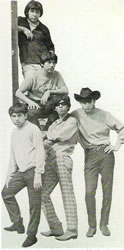 (Top down) Eddie Serrato, Frank Lugo (Bottom L to R) Frank Rodriguez, ?, Bobby Balderrama
(Top down) Eddie Serrato, Frank Lugo (Bottom L to R) Frank Rodriguez, ?, Bobby Balderrama
The members of the band were children of migrant farm workers who would travel to Michigan each summer to pick crops and then return to their homes in Texas when the harvest was complete. When the boys grew old enough, they would work in the fields as well.
Bobby Balderrama was encouraged him to play the guitar by his father, who not only played guitar himself but also the accordian, violin, and harmonica. Bobby got his first real introduction to rock and roll guitar, however, while picking strawberries near Standish, Michigan. He was very impressed by a fellow farm worker named Dave Garcia who both looked and played guitar like the late Ritchie Valens. Garcia showed Bobby some basic chords while sitting on the tailgate of the Balderrama’s family station wagon and stressed to him the necessity of practice if he wanted to be good on the instrument. It was a lesson that Bobby would eventually embrace, and it was also the first glimmer of what Balderrama would decide to do with the rest of his life.
Michigan’s booming auto-based economy eventually offered steady employment opportunities for the Mysterians’ parents that provided far better pay, benefits, and working conditions than they could ever hope to find in Michigan’s fields and orchards. As a result, their families bought homes in the Saginaw Valley and the children were enrolled in local schools.
Original band members – Guitarist Bobby Balderrama, bassist Larry Borjas, and drummer Robert Martinez, first started playing together at Larry’s house in Saginaw, Michigan, in 1962. Brought together by their common love of rock and roll, the trio set out to master some of the popular instrumental hits of the day by The Ventures and Duane Eddy. After jamming together for over a year, the young band got its first gig with an offer to play at a Greek Orthodox Church in Saginaw.
1964 marked the arrival of the British Invasion and the rise of self-contained bands that stressed vocals and dynamic stage presentations. Needing a singer to keep pace with the latest trends, Robert Martinez suggested his older brother, Rudy. The band had already started to learn the songs of The Beatles and The Rolling Stones, and they had Rudy Martinez who, from a young age, had dreamed of being a singer or a dancer on American Bandstand. He was a natural born front man whose singing style and stage moves suggested a Mexican-American version of Mick Jagger.
Rudy and Robert were born in Texas in 1945 and 1946 respectively, and their parents, John and Irene Martinez, had moved with their young family to Saginaw's east side shortly thereafter. According to the Saginaw City Directory of 1948, they lived at 519 Third Avenue, and John was listed as an iron pourer at the Central Foundry in Saginaw. Martinez family then moved to a home at 510 Fourth Avenue where they lived until 1962. After John Martinez was promoted to an inspector at Malleable Iron, he purchased a home in a nicer part of Saginaw at 820 Howard Street. 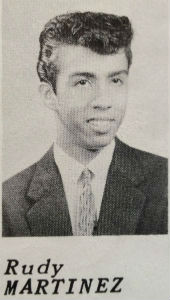 Saginaw High 1962
Saginaw High 1962
Rudy Martinez attended Saginaw High School and his school photos can be found in the 1960, 1961, and 1962 editions of its Aurora yearbook. His senior photo shows a young man in jacket and tie with slicked-back hair style still popular in the early years of the decade. The Saginaw Directory listed Rudy as being employed by the Illinois Shade Cloth Company of Saginaw from 1963 to 1967. The company produced window shades, shade rollers, map rollers, movie screen rollers, lattishades and drapes, lattisdors, and porch shades. It wasn't until the 1968 Saginaw Directory that 'entertainer' was listed as Rudy's employment.
The group's new line up needed a name, and for a while they toyed with the idea of calling themselves the Cadets and dressing in military-styled stage outfits. Larry Borjas eventually came up with the band name after watching a Japanese science fiction movie called The Mysterians on television. The plot of the 1957 film involved aliens from the doomed planet Mysteroid who invade earth wearing capes, round helmets, and dark glasses while looking to mate with Earth women. Although skeptical at first, the other band members eventually decided 'The Mysterians' was both cool and stylish and adopted it as their moniker.
It was while playing a teen dance at Saginaw’s G. I. Forum that The Mysterians met their first manager, David Torres. Torres, who worked at Dow Chemical, was impressed by the frenzied reaction of the girls at the dance, and by the fact that he had never before seen a rock band in which all of the members were of Mexican descent. 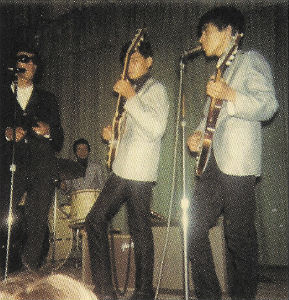 Early Mysterians (L-R) Question Mark, Eddie Serrato, Bobby Balderrama, Larry Borjas
Early Mysterians (L-R) Question Mark, Eddie Serrato, Bobby Balderrama, Larry Borjas
Torres had a number of ideas for the group that included mysterious names for each band member: Bobby would be “X”, Robert “Y”, Larry “Z”, and Rudy, who was already performing in the shades that would become his trademark, would be known as “?”.
The only member of the band who seemed to be able to stick to his new identity was Rudy Martinez. When making a phone call to WTAC deejay Bob Dell to inquire about a booking at the popular teen dances at Mt. Holly outside of Flint, he answered Dell’s question of what his name was by responding that it was “Question Mark”. Dell thought that it was an interesting angle, and whenever he booked them at Mt. Holly he promoted the band on his daily radio show as “Question Mark & The Mysterians”. The tremendous publicity generated on the region’s most powerful AM station led to the band permanently adding the symbol “?” to its name and for its lead singer to eventually legally adopt it as his.
? and The Mysterians were now beginning to incorporate some of their own tunes in their sets that included covers of the hits of the day like “I Saw Her Standing There”, “Satisfaction”, and “Wooly Bully”. Many of the groups of the day such as the Dave Clark Five, Manfred Mann, and the Animals featured keyboard players. These bands were performing on the weekly music programs Hullabaloo and Shindig, as well as the Ed Sullivan Show on Sunday nights.
The Mysterians would soon add a keyboard player of their own, but only after an incident at a practice session at the Balderrama family farm in Monitor Township that threatened the stability of the band's original line-up. Larry Borjas quit the band after a musical disagreement during a band rehearsal. Question Mark convinced him to return after a couple of weeks and, when Borjas rejoined, he gave them the name of a keyboard player that he felt would be good for the band.
Thirteen-year-old Frank Rodriguez of Bay City had been playing piano since the age of five. Frank's father was a musician who nutured and encouraged his talented son. Mr. Rodriguez worked at the Saginaw Steering Gear plant, and the family home in 1965 was located at the corner of 1301 Second St. in Bay City. Shortly before being asked to join the Mysterians, Frank and his sister had ventured a block and a half south on Sheridan to Jay Bosco's house, where he and his teen garage band, the Trespassers, were rehearsing. Frank expressed his interest in joining the band but only if his sister could play drums. Since the Trespassers already had a drummer, they passed on the offer.
Shortly thereafter, the Mysterians auditioned Frank and he joined the band without his sister. The final piece of the puzzle was in place for the Mysterians; but if Frank and his sister had joined the Trepassers, rock and roll history would have been changed. Frank's keyboards were an integral part of the Mysterian's eventual success. "96 Tears" would probably not have been a national hit without his contributions, and ? and the Mysterians would have likely ended up as just one more mostly forgotten mid-Michigan garage band that released a single or two on a small independent record label. 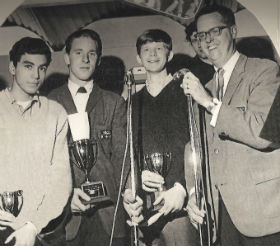 Roll-Air Battle of the Bands 1965: Larry Borjas, Hal Fitzpatrick, Charlie Kazmierski, Bob Dyer WKNX
Roll-Air Battle of the Bands 1965: Larry Borjas, Hal Fitzpatrick, Charlie Kazmierski, Bob Dyer WKNX
Instead, with all the pieces in place, ? and The Mysterians competed in the statewide “Battle of the Bands” held at Roll-Air on State Park Drive in Bay City during the summer of 1965. They finished third behind the Motor City Bonnevilles and a young Bay City band called the Mustangs. David Torres began to lose interest in managing the band around this time, and they were once again on their own.
Every band’s dream in the 1960s was to make its own record and ? and The Mysterians were no exception. Question Mark's brother-in-law, Eddie Serrato, played drums in a traditional Mexican band and knew a club owner in Detroit who booked musical acts and also owned a small recording company. After an audition, the owner was impressed enough with the young band to take them into his studio in February of 1966 and have them record two songs: “Are You For Real?” and “I’ll Be Back”.
Unfortunately, the club/studio owner was murdered in Detroit shortly after the recording session and any plan for a record release was now in limbo. To further complicate things, both Larry Borjas and Robert Martinez were about to be drafted. The pair decided to enlist in the service on the buddy system and were soon stationed in Germany.
The band was now without a bassist and drummer and things seemed to be on the verge of falling apart. Question Mark, Bobby, and Frank continued to practice and jam together at the new Rodriguez home on Wheeler Road in Bay City as they planned their next move. One day as Frank improvised an interesting organ riff, Question Mark to start singing the lyrics to a song he had started writing some years before with the working title of “Too Many Teardrops”. It was the beginning of a rock and roll classic, but first they had to find another drummer and bassist to fill out the band. 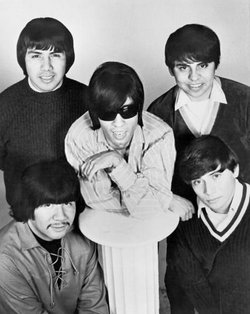 (Top row) F. Lugo, Q. Mark, F. Rodriguez (Bottom row) E. Serrato, B. Balderrama
(Top row) F. Lugo, Q. Mark, F. Rodriguez (Bottom row) E. Serrato, B. Balderrama
After auditioning several drummers in Bay City and Saginaw, the group convinced Eddie Serrato to leave his traditional Mexican band and to come on board. Eduardo "Eddie" Serrato was born in Texas in 1945, the son of Emilio and Celedonia Serrato. Eddie attended Saginaw High with Rudy and Robert's younger sister Mary. Eddie and Mary dropped out of school and were married in January of 1963. Following their marraige, the young couple lived in the Serrato family home at 1350 Carroll in Saginaw where their first child, Eduardo Jr., was born. Meanwhile, Eddie's father helped get him a good paying job at the Chevy Grey Iron plant.
According to a VH1 segment on the band broadcast many years later, as the band continued to work on “Too Many Teardrops”, Serrato suggested they change the title of the song to a certain number of teardrops. After first considering Eddie’s “69 Tears” idea, the band realized that the sexual connotation would probably limit any radio play and simply turned the numbers around to “96 Tears”. Despite the collaboration with other members of the group in putting “96 Tears” together, the songwriting credit was assigned solely to Question Mark under the name R. Martinez.
The next step was how and where to get this new song recorded. Serrato knew of a grocery store owner and businesswoman in Saginaw named Lilly Gonzales whose husband owned a small record label. Hoping that she might be able to help them out, the band auditioned for Gonzales who indicated that she would be interested in both managing and recording ? & The Mysterians. She then booked them into the Schiell's Recording Studio in April of 1966. Lilly's musician brother-in-law, Rudy "Tee" Gonzales, was brought in to produce the session. 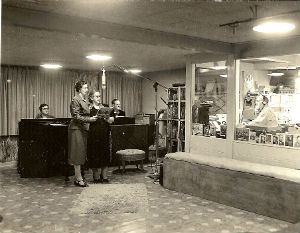 Schiell Recording Studio (Art Schiell in booth)
Schiell Recording Studio (Art Schiell in booth)
The studio was operated by 64-year-old Art Schiell and was located in the back of his small house at 405 Raymond Street in Bay City. The advertisements for Schiell's studio mentioned tape and disc recordings for weddings, orchestras, for sales, and for personal use. By the 1960's, Art Schiell had branched out into recording some of the young rock and roll bands in the Bay City-Saginaw area. The small, but well-equipped facility was situated in an addition at the rear of the home he shared with his wife Mildred. It had storm windows with heavy curtains along with tiles on the walls and ceiling to improve the sound quality in the space.
Because the Mysterians were lacking a bass player, producer Rudy Gonzales recruited Fernando Aguilar from his San Antonio-based band, Rudy & The Reno Bops, to play bass during the session. Both Gonzales and Aguilar were performing in Saginaw at the time. With barely enough room for all of their equipment, the Mysterians recorded “96 Tears” along with another R. Martinez composition titled “Midnight Hour”. Although Question Mark firmly believed that "96 Tears" was a hit, the decision was made in a band vote that “Midnight Hour” would be the best choice for the A-side of their new single. 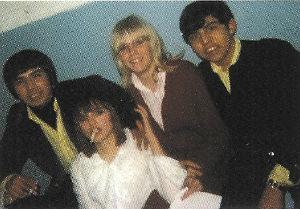 Frank Lugo and Frank Rodriguez with fans
Frank Lugo and Frank Rodriguez with fans
Frank Lugo was then brought in to fill the permanent bass position in the band. Lugo was 19 when he joined the Mysterians. Having two Franks in the band resulted in Rodriguez being given the nickname of "Little Frank" and Lugo being named "Big Frank". A native of Saginaw, Lugo's mother encouraged him to become a priest when he was growing up, but he told her that he wanted to be a musician instead. With his mother's eventual blessing, Lugo pursued his love of music, which he described as "the universal language." A year after joining the Mysterians, Frank married Gloria Borjas. Adding to the family connections in the band, the new Mrs. Lugo was Bobby Balderrama's niece.
By late April, 750 copies of the record were pressed on the Pa-Go-Go record label. The small San Antonio-based record company was owned by Lilly's husband, Jose 'Pato' Gonzales, along with Rudy and Manuel Gonzales. Lilly Gonzales gave most of the copies of the single to the band and instructed them to sell them at their gigs, take them to record stores, and visit area deejays to try to get their songs played on the radio.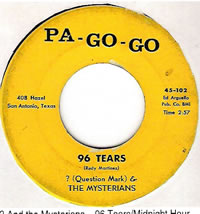
The band began promoting the record all over Michigan. WSAM in Saginaw was the first station to play “Midnight Hour” on a program spotlighting new talent; but Question Mark firmly believed that “96 Tears” was going to be the hit and went back to the station the next day and got the deejay to flip the record over.
The response from listeners to “96 Tears” was immediate. Deejays Bob Dyer and Dick Fabian from rival station WKNX in Saginaw also got behind “96 Tears”, and it soon became a big radio hit in the Bay City-Saginaw area. The local popularity of the song led to Bob Dell putting it on the playlist of Flint’s WTAC. The station's powerful signal helped to break “96 Tears” into the Detroit market, and the song soon became a # 1 hit on the fifty-thousand-watt AM giant, CKLW.
Despite pressing 500 more copies of the single, the increased demand for “96 Tears” could not be met by the tiny Pa-Go-Go label, so the single was quickly picked up by Cameo-Parkway. The record label had loads of hits in the early 60’s by the likes of Bobby Rydell, Chubby Checker, the Orlons, the Dovells, and Dee Dee Sharp but had been in a serious sales slump since the arrival of The Beatles and the other British Invasion bands. Cameo-Parkway vice president Neil Bogart cut a deal with Lilly Gonzales for the national distribution on “96 Tears” and re-released the single on the Cameo label.
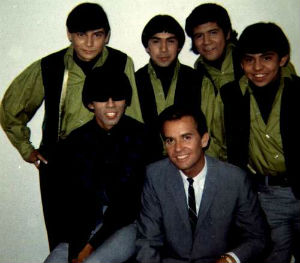 With Dick Clark on American Bandstand
With Dick Clark on American Bandstand
Neil Bogart, the 23-year-old vice president and sales manager at Cameo-Parkway traveled to Michigan and bought the master to "96 Tears" ahead of Morris Levy, head of Roulette Records in New York City, who had already made a tentative deal with Pa-Go-Go over the phone. Bogart then promoted the song tirelessly, traveling with the band to the east coast and then flying with them to Los Angeles to appear on American Bandstand and Where The Action Is.
Bogart's legwork soon started to pay dividends. "96 Tears" entered the Billboard chart at # 112 and began climbing. On September 3, 1966, “96 Tears” debuted on the Billboard Hot 100 at # 75. Against all odds, on October 29,1966, ? & The Mysterians accomplished the unthinkable. “96 Tears” had climbed steadily up the charts all during the fall, and the song they had recorded in a small studio in Bay City had finally become the # 1 single in America.
Seemingly overnight, the band went from playing mid-Michigan teen clubs and dances to national television appearances. They were now being represented by the Premier Talent Agency out of New York City and were sharing concert stages on Dick Clark’s package tours with the likes of the Beach Boys, the Mamas & the Papas, the Four Seasons, and Jay & The Americans.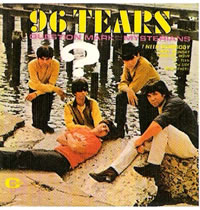 96 Tears LP
96 Tears LP
As “96 Tears” was emerging as Cameo-Parkway’s biggest hit in the last three years, the label brought the group into the Allegro Sound Studios in New York City to record some new tracks for use as possible singles and on their debut album. Eleven of the twelve songs that ended up on ? & The Mysterians’ excellent debut LP, “96 Tears”, were written by group members. This was highly unusual for a new band. Even established groups such as the Beatles and the Rolling Stones had only just released their first albums of all original songs in America earlier in the year.
The lead track on the album, “I Need Somebody”, was released as the band’s second single in November of 1966, backed with "8 Teen". It was an uptempo dance tune with a great Question Mark vocal that was dripping with street punk attitude. Little Frank Rodriguez inserted a brief organ segment of “Mary Had A Little Lamb” on the song as a tribute to Saginaw native Little Stevie Wonder. Stevie had done the same thing with his harmonica on his # 1 hit “Fingertips” in 1963.
Although not as instantly catchy as “96 Tears”, “I Need Somebody” was a solid hit single, peaking at # 22 on the Billboard charts in December. ? and The Mysterians capped off an incredible year when they were presented with gold records for “96 Tears” in a special ceremony in their hometown that was held at the Saginaw Auditorium. 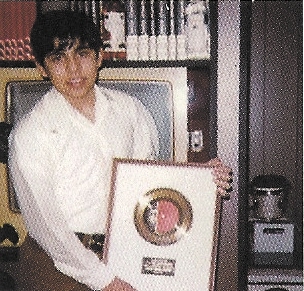 Frank Rodriguez with "96 Tears" Gold Record
Frank Rodriguez with "96 Tears" Gold Record
When Billboard published its year-end chart of the Top Records of 1966, "96 Tears" was listed as # 2. The song had spent more weeks on the Hot 100 than every single released that year except "California Dreamin'" by The Mamas & The Papas. This meant that ? and The Mysterians' big hit out-performed hit singles in 1966 by The Beatles, The Rolling Stones, The Supremes, The Monkees, and The Beach Boys.
Another benefit of Cameo-Parkway's good fortune with ? and The Mysterians is the fact that several other important Michigan acts were signed to the label as a direct result of the success of "96 Tears". Question Mark claims to have recommended Terry Knight & The Pack, Bob Seger, and The Rationals to label representative Neil Bogart; and all three acts charted singles for Cameo-Parkway in 1966 and 1967.
The first sign of trouble between ? and The Mysterians and Cameo-Parkway came during the recording of the band’s third single. Producer Neil Bogart wanted the group to record a song called “Can’t Get Enough Of You Baby” that was written by Sandy Linzer and Denny Randell. The song had first appeared as a cut on an album they had produced for the Toys ("A Lover's Concerto"), and the song had also appeared on an album by the Four Seasons. Bogart wanted the Mysterians to duplicate the organ and guitar riffs of “96 Tears” on "Can't Get Enough Of You Baby" to make it sound more like their big hit. 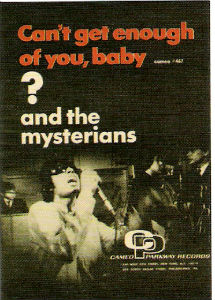
This practice of making sound-alike follow-up singles was common record company practice in the 1950’s and early 1960’s, but the playing field had changed by 1967. When Question Mark and Bobby Balderrama expressed their opinion that it was a bad idea, Bogart told him that there were a lot of session musicians more than willing to take their place if they didn’t want to play what they were told.
The band somewhat reluctantly followed orders and recorded a very good sound-alike single. The record might have been a bigger hit if it had been released right after "96 Tears", but “Can’t Get Enough Of You Baby” b/w "Smokes" only reached # 58 on the charts in the spring of 1967 as their struggling record company had already began to scale back its promotional efforts. Strangely enough, Cameo-Parkway also decided to release two more ? & The Mysterians' singles in 1967 under the pseudonyms of The Semi-Colons and The Fun Sons. Both of these “joke” records sank without a trace.
The group was optimistic that their fourth single, “Girl (You Captivate Me)” backed by “Got To”, would put them back on top. The sound of “Girl” featured Bobby’s guitar played through a fuzz box to great effect and a snarling vocal by Question Mark. In an attempt to give the song more edge, Question Mark substituted the lyric "Girl you masturbate me" for the original line "Girl you fascinate me"; but Cameo-Parkway once again failed to give much promotion to the single.
Somewhat surprisingly, the song was performed on American Bandstand on June, 10, 1967. The video is available on Youtube, and it shows Question Mark lip-synching the song without any of the other Mysterians in sight. Perhaps because the lyric "masturbate" was altered when it was broadcast, it became a classic “mondegreen” (a term given to misunderstood song lyrics) for a large number of listeners. Many thought they heard “Girl you masticate me”, thinking that no song featured on AM radio or introduced by Dick Clark on American Bandstand would contain the word "masturbate". But "Girl (You Captivate Me)" featured the unmentionable and, once the word got out, the song was taken off most radio playlists. As a result, the single barely scraped into Billboard at # 98. It would also prove to be the band's final entry on the Hot 100.
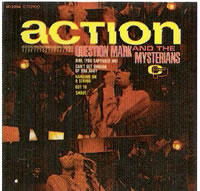 "Action" LP
"Action" LP
? and The Mysterians’ second and last album on Cameo was released in June of 1967. Titled “Action”, the album contained the third and fourth singles but no group compositions. All five of the original songs were credited to R. Martinez.
The band's final single for Cameo was another great two-sided record, pairing the catchy “Do Something To Me” with a cool group original called “Love Me Baby (Cherry July)”. Unfortunately, its release coincided with the death rattle of the Cameo-Parkway label. The single was only able to reach # 110 on the Billboard charts with little or no company support as the Cameo-Parkway label was shut down a month after its release. “Do Something To Me” did, however, become a Top 40 hit the next year on another label when covered by Tommy James & The Shondells.
The band was profiled in the Saginaw News by staff writer Sara Smith in the November 12, 1967 edition of the paper. Her upbeat story foocused on the band members and their families and even included their home addresses. In the article, the band members blamed their record company (Cameo-Parkway) for the lackluster success of their last three singles and the "Action" album, and declared that they were about to sign a new record deal. In addition, the story revealed that the band had a warm relationship with their manager Lilly Gonzales, describing her as "wonderful, just like a second mother to us all." Gonzales also managed a young Saginaw band called Count and the Colony who were included in the photo accompanying the story and were about to open for the Mysterians on an upcoming tour of Texas. 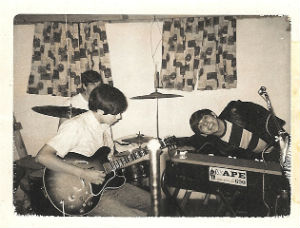 Substitue drummer Charlie Brunner, Bobby Balderrama, and Frank Rodriguez rehearsing.
Substitue drummer Charlie Brunner, Bobby Balderrama, and Frank Rodriguez rehearsing.
Question Mark was quoted in the article as saying: "For a while there, Saginaw and home were just memories. Kids in Saginaw are the grooviest. They are exposed to more big name bands, and they expect more from a band. They really feel the music." He went on to add: "We never have felt like a big group. You have to be on top for about four years to feel that way, like the Beatles or the Mamas & the Papas. We don't have big heads yet."
Smith reported that Question Mark's major problem at personal appearances is the girls who try to grab his glasses. She also wrote that he was entertaining some thoughts of solo projects including a bid to audition for the Kraft Music Hall and the possibility of a TV series. Smith also disclosed that he removed his wrap-around sunglasses only to sleep, and that this was a part of the group's gimmick, like never revealing Question Mark's real name. The article went on to state that the five young men in the band enjoyed meeting new people on tours, but were happy that their time in Saginaw was more plentiful than during the past year when "96 Tears" was at the top of the national record charts. Everything looked rosey for the group as they approached the new year.
Instead, 1968 would turn out to be a year of turmoil and change for ? & The Mysterians. The year started off well when the band signed with Capitol Records and recorded another fine single, “Make You Mine” backed with “Love You Baby (Like Nobody’ s Business)”. Unfortunately, the single did not catch on and failed to chart. The music scene was changing very fast and to add insult to injury, Jim Morrison of the Doors, one of rock's influential new stars, took a swipe at the band. He was quoted in the music press as saying; "I don't like bubblegum music like Question Mark & The Mysterians and the Monkees." 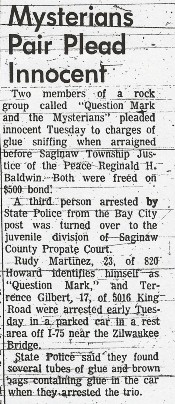 Saginaw News
Saginaw News
But the worse was yet to come. On April 2,1968, the band was the recipient of some very negative publicity when Question Mark, Terrance Gilbert, and a 15-year-old Saginaw juvenile, were arraigned in the Saginaw County Justice Court on charges of glue sniffing. The trio was arrested by State Police troopers from the Bay City post at a rest area on I-75, just north of the Zilwaukee Bridge.
According to newspaper reports carried around the state, the officers were on routine patrol when they discovered several bags filled with glue after investigating the parked vehicle. Question Mark and Gilbert were released on $500 bond after standing mute to the charge, while the juvenile was turned over to the Saginaw County Probate Court.
The hearing held at the end of the week was adjourned after defense attorneys for Question Mark requested a jury trial on the glue sniffing charge. But the damage had already been done. Glue sniffing was considered uncool by the vast majority of fans and record buyers, and the singer became something of a laughingstock as the result of the incident.
The fallout from the bust also cost the band the services of Jim Leach who had been promoting the band's releases around the country on weekends and during holidays. Leach was also employed as a full-time teacher at Saginaw's Buena Vista High School, and was given the choice of either giving up his job with the Mysterians or resigning from his teaching position.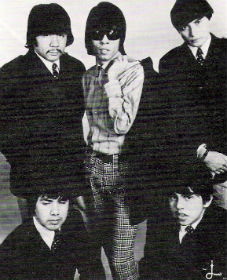
It was during this turbulent time that ? and The Mysterians separated from their manager Lilly Gonzales in a dispute over money and her managerial decisions. Question Mark claimed that Gonzales' demands to the label were to blame for the collapse of the band's deal with Capitol. Inexperienced in financial matters, Gonzales had also given the band some very questionable advice that resulted in their signing away the copyrights to their original songs recorded at Cameo-Parkway. This very poor business decision still haunts them to this day.
The lineup of the Mysterians was also altered after drummer Eddie Serrato was seriously injured in a car accident and was replaced by Jeff MacDonald and then former Bossmen drummer Pete Woodman who played with the band for almost a year. In addition, Frank Lugo decided to quit the band in order to spend more time at home with his new wife. He was replaced on bass by Lee Shrieve. Later in the year, the band signed with Ray Charles’ Tangerine record label in California, which was distributed nationally by ABC-Paramount.
? and The Mysterians began recording an album, and Little Frank Rodriguez got the thrill of his life when Ray Charles came to the studio one day and sat down at the keyboards with him. Tangerine eventually released one unsuccessful single from the sessions in 1969, “Ain’t It A Shame” b/w “Turn Around Baby (Don’t Ever Look Back)”, but the album was never released. It is the great lost ? and The Mysterians LP that is still locked away in somewhere in the vaults. According to Bobby Balderrama, the “lost album” showed the band moving in some new directions as the 1960’s drew to a close. 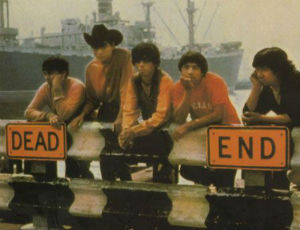 Photo shoot in New York City
Photo shoot in New York City
The last ? and The Mysterians single of the decade was “Sha La La”, released on the Super K Records. The label was run by producers Jerry Kasenetz and Jeffrey Katz, whose groups specialized in bubblegum pop. Super K had enjoyed success with the Ohio Express, the 1910 Fruitgum Co., Crazy Elephant, and the Music Explosion but by the time that ? and the Mysterians signed on, the bubblegum genre had begun to decline in popularity and their lone single for the label failed to chart. The only original band members on the record were Frank Rodriguez and Question Mark as Bobby Balderrama had left the group to go back to school. After Frank Rodriguez left shortly thereafter, the Mysterians became a revolving door of musicians with the vocals of Question Mark being the one constant.
Question Mark's next stop was Delta Promotions, a Bay City management and booking company run by Bill Kehoe and Jim Atherton. Delta's biggest act at that time was The Pack, featuring Mark Farner and Don Brewer. Kehoe and Atherton also represented a soul band called Junior Lewis and The Selections, and a power trio of brothers named Dick Rabbit.
Delta Promotions also put together and booked three highly questionable acts who were billed as 'The Animals', 'The Archies', and 'The Zombies'. None of these bands included any of the people who had recorded the big hits or had toured with the original members. The Archies was really a studio group created by Don Kirshner who had a # 1 hit with "Sugar, Sugar". The Zombies of "She's Not There" and "Time Of The Season" fame was a British rock band that had disbanded in late 1967. The Animals, also from England, had dissolved in late 1968. Featuring the lead vocals of Eric Burdon, the band had recorded 18 charting hits, including the # 1 smash "House Of The Rising Sun" in 1964.
 Question Mark at Delta Promotions (Top L-R) Chris Corral, Berlin Speak, Les Merrill.
Question Mark at Delta Promotions (Top L-R) Chris Corral, Berlin Speak, Les Merrill.
\With the original band in shambles, Question Mark talked all of the former members into giving him the band name and any future royalties in exchange for a large royalty check he was holding. That gave him sole rights to the name '? and the Mysterians', which he still controls today.
The one-sided agreement may very well have been brokered by Bill Kehoe of Delta Promotions which had Question Mark as a client. A Bay City business man and former owner of the Band Canyon teen club, the 40-year-old Kehoe was serving as Question Mark's manager and reportedly received a check equal to that of the other Mysterians as part of the settlement.
Represented by a lawyer with no experience or knowledge of the music business; Rodriguez, Serrato, Balderrama, and Lugo were advised to accept the offer. It was a bad deal for the other Mysterians but a very good one for Question Mark. He was able to maintain his career with the recognition from the band name during the ensuing decades and today is the only member of the Mysterians receiving any royalties. 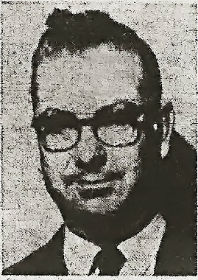 Bill Kehoe - Delta Promotions
Bill Kehoe - Delta Promotions
Just three years after having the # 1 hit in the country, ? & the Mysterians were pretty much considered has-beens in Michigan where they had been superseded by more aggressive acts like the MC5, the Amboy Dukes, and the Stooges. An indication of how far the band had fallen was illustrated by a concert held at the Saginaw Auditorium in June of 1969, shortly after Frank Rodriguez left the band. ? and his new line-up of Mysterians co-headlined the show with the fake Zombies, and they were supported by two other Delta Promotions acts, Dick Rabbit and Junior Lewis and the Selections.
The Saginaw News covered the event and panned the concert, calling it "a complete bomb." The reviewer, Rick Curtindale, stated that the 40-minute performance of Question Mark and his new lineup of hired hands, which incidentally did not include a keyboard player, was met with "dead silence" by the audience. Curtindale went on to declare: "The Zombies were especially disappointing and the crowd began to leave during their fourth tune."
Similar reports from other bookings of the fake bands led to a front page investigative report in Rolling Stone magazine in 1970 criticizing Delta's unethical use of the 'Zombies', 'Archies', and 'Animals' names to deceive out-of-town promoters and fans.
Delta Promotions was located in a building located on Tuscola Road in Bay City. It featured a large room that was a perfect rehearsal space for the bands on the Delta roster. According to Kristofer Engelhardt's Mark Farner biography, From Grand Funk To Grace, Farner and Don Brewer were looking to put together another band after the breakup of the Pack. They wanted to form a power-trio along the lines of Cream or the Jimi Hendrix Experience, but they needed a bass player.  Former home of Delta Promotions
Former home of Delta Promotions
While visting Delta Promotions, they watched part of a ? and the Mysterians' rehearsal and were impressed by the band's bass player. Mel Schacher was a Flint native who had been serving as both the road manager and bassist for the Mysterians but was unhappy with the arrangement. Farner and Brewer asked Schacher to join them in the band that became Grand Funk Railroad after they left Delta Promotions and signed a management deal with Terry Knight.
The Mysterians replaced Schacher with Adam Lugo who was later replaced by Richie Schultz, a Bay City native who had been playing bass with Junior Lewis and the Selections. Question Mark had seen Schultz rehearsing at Delta Promotions and asked him to join after Lugo left. Oddly enough, Schultz had previously been a member of The Trespassers, the Bay City teen band that Frank Rodriguez had wanted to join back in 1965.
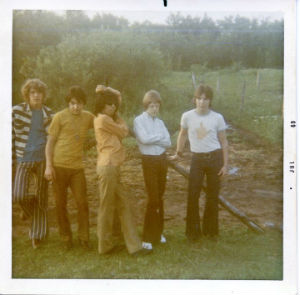 1970s (L to R) Scott Frost, Richie Schultz, Question Mark, Al Wotton, Tony Alvarez
1970s (L to R) Scott Frost, Richie Schultz, Question Mark, Al Wotton, Tony Alvarez
The band did not go into the studio again until 1972 when they recorded "Talk Is Cheap" b/w "She Goes To Church On Sunday" for Frank Slay's Chickory label in California. Question Mark knew Slay from 1966 when the Mysterians were signed to Cameo-Parkway.
Slay had moved to New York in the 1950's and formed a songwriting partnership with Bob Crewe. The duo wrote "Silhouettes" for The Rays as well as "Tallahasseee Lassie" for Freddy Cannon. Besides producing most of Cannon's hits, Slay also became the A&R director for Swan Records. After he moved to California, Slay produced "Incense and Peppermints", a # 1 hit for the Strawberry Alarm Clock in 1967.
Frank Slay produced the session and insisted that each song include an organ part that was at least a reminder of the original Mysterians' sound that was built around Frank Rodriguez's keyboard on "96 Tears". Both songs were credited to R. Schultz and R. Martinez. Schultz recalled that "She Goes To Church On Sunday" was a much heavier song before Slay got his hands on it in the studio and changed it into a more "bubblegum" production. 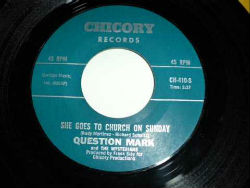 Chicory 45
Chicory 45
Schultz went on to say that the single received very little promotion from Chicory and sank without a trace. At least two other songs were recorded at the session but were never released. Schultz also claimed that after Frank Slay sold the label, the songs ended up with Paul McCartney's publishing company in New York.
The following year, ? and the Mysterians recorded another single, "Hot 'N Groovin'" b/w "Funky Lady" on Luv Records out of Detroit. Brian Bennett, formerly of the Cherry Slush, was brought in to play keyboards. Both songs were again credited to Schultz and Martinez. The single got some Michigan airplay, mostly in the Detroit area. Looking back, Schultz felt that the producers should have slowed the songs down. He recalled that the band was young and wild in the studio and the groove was lost because they played the songs too fast.
Following Bill Kehoe's decision to close Delta Promotions in the wake of a lawsuit by Kirshner Productions in New York that controlled the music property of The Archies, Question Mark took on new management that had no experience in the music business. As a result, there were no new recordings for the next ten years despite the fact that the band logged a substantial amount of studio time and employed a host of talented musicians. Schultz said he quit out of frustration several times because of the poor managerial decisions and missed opportunites but Question Mark would not part with his manager. Schultz made ends meet by gigging with other bands at the same time he was playing with the Mysterians; but he finally quit for good in 1983. 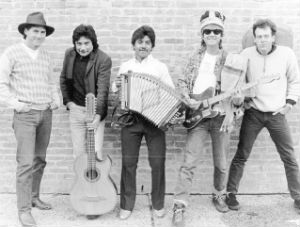 Bobby Balderrama (2nd from left) with Joe "King" Carrasco Band
Bobby Balderrama (2nd from left) with Joe "King" Carrasco Band
Bobby Balderrama eventually got back into the music scene in two Michigan bands: The Sa-ith (pronounced “sayeth”) with Frank Rodriguez, and In Flight with Frank Lugo and Richie Schultz. He also played guitar for a number of years in the band of Joe “King” Carrasco.
Carrasco's blend of garage rock, Tex-Mex, and Tejano music was partly inspired by ? and The Mysterians. Carrasco was the one who arranged for a reunion performance of the original Mysterians at one of his shows in Dallas, Texas in 1984. The concert was recorded and released the next year as “96 Tears Forever: The Dallas Reunion”.
After a series of sporadic comeback performances in Michigan, including a number of shows in Bay City and Saginaw, the original band reunited for good in the late 1990’s. Composed of Question Mark on lead vocals, Bobby Balderrama on guitar, Frank Rodriguez on keyboards, Frank Lugo on bass, and Robert Martinez on drums, the group once again began performing regularly and returned to the recording studio for the first time in almost 30 years. 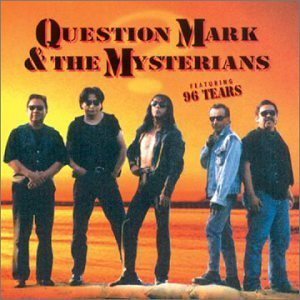 Frank Lugo, Bobby Balderrama, ?, Robert Martinez, Frank Rodriguez - Bullfrog Records CD
Frank Lugo, Bobby Balderrama, ?, Robert Martinez, Frank Rodriguez - Bullfrog Records CD
Because Allen Klein's ABKCO Records had not released the Mysterians' two original albums on CD, the band decided to re-record its debut album plus four additional songs. The project was produced by Chad Cunningham at his Bullfrog Records studio in Bay City, Michigan. The resulting album, "Question Mark & The Mysterians featuring 96 Tears", was distributed by Collectibles Records
The band got some unexpected national exposure when the songs “96 Tears” and “Can’t Get Enough Of You Baby” were used in television commercials for Pringles and Honda. Although the publicity was great, none of the band members other than Question Mark profited financially. ? and The Mysterians also received glowing reviews in Rolling Stone magazine for a 1998 performance at the New York City nightclub, Coney Island High. The resulting live recording, “Do You Feel It Baby?”, was released on Norton Records and was hailed by Rolling Stone as one of 1998’s best live albums.
In the late 90's, ? and the Mysterians collaborated with promoter Jon Weiss who made the band headliners at his CaveStomp Garage Rock Festivals. Their highly successful appearances established them as one of the top re-formed 60's bands and one of the very few who could boast an original line-up from that decade.
Weiss brought the band into the studio where he produced and recorded "More Action", a 2 CD album that contained some new studio recordings as well as re-recordings of Cameo material. Of special interest was the inclusion of the two songs, "Are You For Real" and "I'll Be Back" that had been recorded in Detroit early in 1966 and feared lost.
 "More Action" 2 CD
"More Action" 2 CD
Since he owns the sole rights to the band name today, Question Mark is clearly the man in charge of the reunited ? and The Mysterians. He has allowed Balderrama, Rodriguez, and his brother Robert Martinez to perform without him as "The Mysterians" under the conditions that they do no interviews and perform no Mysterians' songs other than "96 Tears". Balderrama, Rodriguez, and Martinez have also appeared as The Semi-Colons, an all-instrumental band that features 60's classics.
Always an interesting and opinionated subject, a Question Mark interview can veer from compelling to absurd in a heartbeat. A true eccentric, he is still never photographed without his trademark sunglasses. The singer is supposedly collaborating on a documentary film on the Mysterians called Are You For Real? but, like many of his announced projects, it has not come to fruition. He has reportedly passed up many lucrative touring offers for the band from around the world and, now that he's in his 70s, seems content to limit his performances and regularly call-in to a number of commercial and internet radio programs from the comfort of his own home.
Question Mark announced several years ago that the band had a new album in the works for Foundation Records with the title “Listen To What’s New”, but it was never released. At a show in the fall of 2014 at Delta College, Question Mark announced from the stage that the band was about to release a new album of rock and roll oldies, including "You Really Got Me" by The Kinks. The album has a working title of "Raw", but it has not yet seen the light of day either.
Besides gigging with the reunited Mysterians, Bobby Balderrama, Frank Rodriguez, and Robert Martinez also played regularly in a side project called the Robert Lee Band. Their self-titled debut album was released on Bullfrog Records in 2001. The group has since evolved into the Robert Lee Revue smooth jazz group with Tom Barsheff on sax, Jack Weston Nash on bass, Nick Balderrama on rhythm guitar, and Amy Lynn Balderrama on percussion and released a CD titled "For The Love Of Smooth Jazz" in 2010. Two years later, the band released a second CD titled "City of Smooth Jazz". Robert Martinez has since been replaced on drums by Rudy Levario. The group's latest release, "The Hall of Smooth Jazz," features "Any Moment," a # 1 hit on the Billboard Smooth Jazz chart.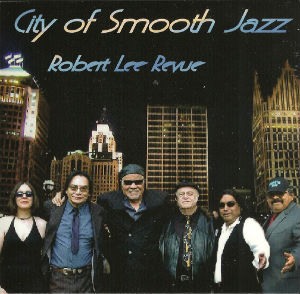 Robert Lee Revue CD
Robert Lee Revue CD
Guitarist Bobby Balderama completed a combination science fiction/documentary video project with the title of ? & The Mysterians The Movie: “It's A Crazzy World”. ? and The Mysterians were also portrayed as appearing on American Bandstand in one of the episodes of the hit television series, American Dreams. These, along with the television ads and covers of their songs by newer bands, have resulted in ? and The Mysterians attracting a somewhat younger fan base.
Like “Louie, Louie” by The Kingsmen, “96 Tears” has maintained its standing as a rock and roll classic for over 50 years. The group will always be remembered for their biggest hit, but it only represents part of the reason they are regarded as the “world’s greatest garage band”. ? and the Mysterians can still bring the goods on stage. Question Mark remains a great front man but the true rock and roll power resides in the four men that make up the Mysterians. Robert Martinez is an outstanding drummer, Bobby Balderrama is stellar on lead guitar, Frank Lugo provides a solid bass, and Frank Rodriguez is unsurpassed on keyboards.
In recognition of their contributions to Michigan's rich musical history, ? and the Mysterians were voted into the Michigan Rock and Roll Legends online Hall of Fame in 2006. 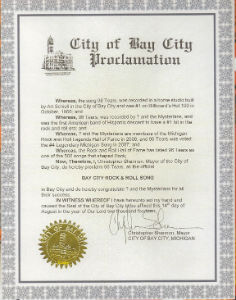 2014 "96 Tears" proclaimed Bay City's Official Rock and Roll Song
2014 "96 Tears" proclaimed Bay City's Official Rock and Roll Song
Unfortunately, Question Mark's fortunes took a turn for the worse in January of 2007 when his house, located in Vienna Township near Clio, Michigan, burned down. Although Question Mark was not injured, some of his dogs as well as rock and roll memorabilia from his career dating back over forty years were lost in the blaze. On a very sad note, former drummer Eddie Serrato passed away from a heart attack in 2011.
In the spring of 2007, ? and the Mysterians' recording of "96 Tears" was voted into the # 4 position on the list of Legendary Michigan Songs. In 2014, "96 Tears" was offically proclaimed Bay City's Official Rock and Roll Song by Mayor Chris Shannon in a crowded ceremony at the Old City Hall reception room that included a performance by ? and the Mysterians.
Dr. J. Recommends:
“The Best Of ? And The Mysterians, Cameo Parkway, 1966-1967”. This is a collection of all the songs they recorded for the Cameo-Parkway label. They have been unavailable except on bootlegs for many years. This set also includes unreleased run-throughs of “96 Tears” and “Midnight Hour”. 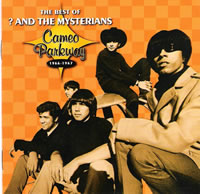
“96 Tears: 30 Original Recordings”, Campark Records. This bootleg also has all the Cameo-Parkway recordings. What makes this CD unique is that it also includes the three great singles from Capitol, Tangerine, and Super K that are not on Cameo Parkway's “The Best Of” collection.

